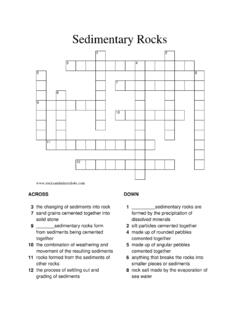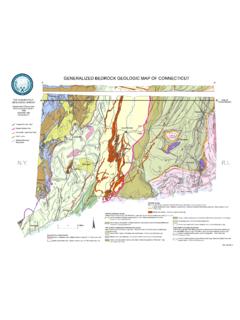Transcription of Al – Aluminium
1 53Al Aluminium Introduction Aluminium is a member of group 13 of the periodic table, which also includes B, Ga, In and Tl. The element has an atomic number of 13, an atomic mass of 27, one oxidation state (+3) and one naturally occurring isotope (27Al). The geochemical behaviour of Al is very similar to that of its group neighbour Ga. Aluminium is a lithophile element and is the most abundant metal in the lithosphere, forming several of its own minerals, including sillimanite Al2 SiO5, corundum Al2O3 and kaolinite Al2Si2O5(OH)4. It is exceeded in abundance only by oxygen ( ) and silicon ( ) (Ildefonse 1999).
2 It is a major constituent in many rock-forming minerals, such as feldspar, mica, amphibole, pyroxene and garnet. The weathered products of primary Al minerals include secondary clay minerals, , kaolinite and dioctahedral smectite, and Al-hydroxides, such as gibbsite, nordstrandite and bayerite, which may control the equilibrium concentration of Al in soil solution, groundwater and stream water. In tropical conditions, weathering may produce the Al-ore bauxite, a mixture of several secondary hydroxide/oxide minerals. Aluminium is present at percent levels in most of the common rock types, and has an average crustal abundance of about (Ildefonse 1999).
3 Metamorphic rocks show both the widest variation, and the highest mean values with respect to Al2O3 concentration. Average values typically range from 12 to 24%, although Al2O3 concentrations as low as 1%, and as high as 28%, have been reported. With the exception of shale, sedimentary rock types commonly contain very little Al2O3 with average contents ranging from <1% to a maximum of in carbonates and ~5% to 8% in sandstone. Shale contains much higher concentrations of Al2O3, typically up to 15%, due to the presence of clay minerals such as kaolinite.
4 Concentrations in igneous rocks generally increase with decreasing Fe and Mn content; ultramafic rocks such as peridotite contain as little as 4% Al2O3, whilst mafic rocks such as basalt can contain up to 16%. Acid igneous rocks on average have Al2O3 concentrations in the range 15 to 25%, the higher values corresponding to igneous rocks rich in feldspar, such as anorthosite and nepheline syenite (Wedepohl 1978) and late tectonic peraluminous granite in the Variscan basement (Faure et al. 2004). McLennan and Murray (1999) quote average values for river particulates and loess as and Al respectively.
5 Although most naturally-occurring Al resides in feldspar minerals and their weathering and alteration products, Al tends to correlate with elements such as Fe, Cr and V in weathered material, and can be used, therefore, as an indicator for the presence of mafic rocks . Aluminium has a low mobility under most environmental conditions, although below pH its solubility increases as it is released from silicate rocks (Shiller and Frilot 1996). Because of its amphoteric nature, Aluminium may also be mobilised in anionic form under strongly alkaline conditions at pH values above 8 (Shiller and Frilot 1996).
6 The speciation of aqueous Al is dependent on both pH and the presence and nature of complexing ligands. In the absence of significant concentrations of complexing ligands, the dominant form of dissolved Al below about pH is Al3+ (Martin 1992). Above pH , the hydrolysed forms Al(OH)2+ and Al(OH)2+ account for a significant amount of the total dissolved Aluminium . At low pH, organic ligands, including humic and fulvic acids, and inorganic ligands, such as fluoride, readily complex with dissolved Aluminium , and can increase its equilibrium solubility in solution.
7 Dissolved organic carbon affects the release of Al through complex formation in the upper soil layer, while other mechanisms operate in the lower B-horizon (Kabata-Pendias 2001). Soil acidification arising from atmospheric deposition of S (mainly SO2), also increases Al solubility in soil, possibly by the formation of soluble Al(OH)SO4. Oxidation of sulphides, , pyrite, in soil gives rise to the production of H2SO4, which interacts with other minerals to produce Al ions that occupy exchange sites. The average total concentration of Al in global soil is reported as 80,000 mg kg-1 (Koljonen 1992, Reimann et al.)
8 1998). As a result of organic complexation, particularly through chelation, a significant proportion of Al in stream water is usually 54transported in colloidal or particulate forms. Concentrations of dissolved Al are generally low in most natural water, because of the low solubility of Al-bearing minerals under near-neutral pH conditions. Stumm and Morgan (1981, 1996) report a median concentration of 11 g l-1 for Al in terrestrial water. Anthropogenic sources of Al include Aluminium smelters, cement plants, sewage and dust (Reimann and de Caritat 1998), but the natural background is usually dominant.
9 Aluminium is considered to be a non-essential element. Dissolved cationic Aluminium is known to be toxic to various species, including fish, invertebrates and plants. Its toxicity depends on its form in solution, , Al is more toxic to fish as the Al3+ ion than if it is complexed (Driscoll et al. 1980). Silicon and Ca have been shown to afford some protection to aquatic vertebrates and humans against the toxicity of Al (Birchall et al. 1989, Exley et al. 1997). Alzheimer s disease is associated with higher than normal amounts of Al in the brain, but it is now thought that this is a consequence, not a cause, of the disease (WHO 1996).
10 Table 8 compares the median concentrations of Al in the FOREGS samples and in some reference datasets. Table 8. Median concentrations of Al in the FOREGS samples and in some reference datasets. Aluminum (Al2O3) Origin Source Number of samples Size fraction mm Extraction Median % Crust1) Upper continental Total Subsoil FOREGS 788 < Total (XRF) Topsoil FOREGS 845 < Total (XRF) Soil2) World Total Water (Al) FOREGS 807 Filtered < m ( g l-1) Stream water (Al)3) World 160 ( g l-1) Stream water (Al)4)





